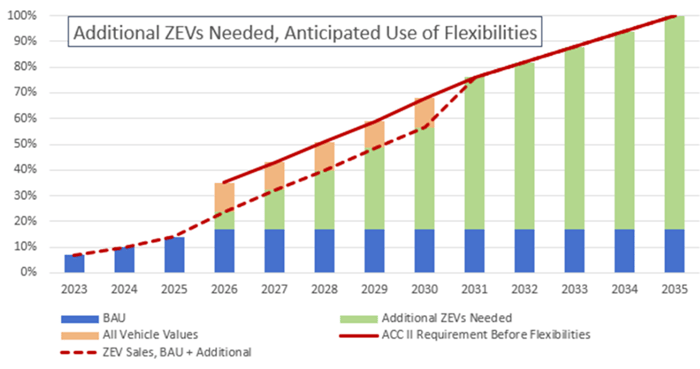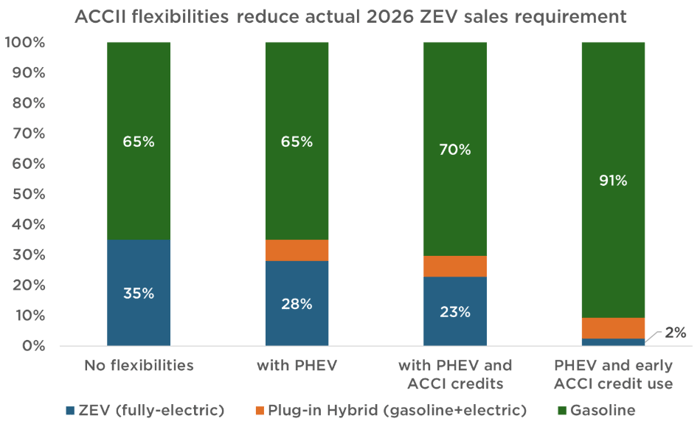Clean car regulations are under attack federally and here in Massachusetts. We wrote about these attacks on April 25, held a webinar on May 1, and submitted joint letter signed by 70 organizations to Governor Maura Healey on May 2. All along the way, we’ve tried to dispel misinformation and disinformation about these key regulations. Last week, the Massachusetts State Auto Dealer Association made a claim in a Boston Globe article about the subject that incorrectly frames how these regulations work. As part of our Truth to Power campaign, we want to set the record straight.
Which regulations are we talking about?
We’re talking about the Advanced Clean Cars II (ACCII) regulations, which gradually require automakers to increase the percentage of electric cars among the fleet of vehicles they deliver to Massachusetts over a ten-year period. As we discussed at length in our webinar and blog post, ACCII regulates automakers, not individual dealers or consumers. Massachusetts adopted these regulations after the necessary public process way back in 2023. And automakers have many options to comply: they can deliver battery-electric vehicles or plug-in hybrids, use credits they’ve amassed in previous regulatory systems, earn early compliance payments for electric vehicles (EVs) they sell before the regulations kick in with model year 2026, earn additional credits for facilitating EV uptake in environmental justice communities, purchase credits from other automakers with an excess, carry over a deficit from one model year to the next, move credits from one state participating in ACCII to another, or, if all else fails, pay a civil penalty to the regulator.
Despite these facts, the Boston Globe this week reported the following:
Here in the Bay State, Robert O’Koniewski, executive vice president of the Massachusetts State Automobile Dealers Association, said his organization has been reaching out to lawmakers and the Healey administration to ask them to slow down.
The issue, he said, is that while some Massachusetts dealers are doing well with selling electric vehicles, others aren’t selling any at all. “Going from zero to 35 percent in one year is just not realistic,” he said. “It’s basic math.”
Advocates note that the program has built-in flexibilities, including allowing for the sale of plug-in hybrids and the use of credits to make it easier to hit the targets, and that it regulates automakers, not auto dealers.
Dispelling Disinformation
Mr. O’Koniewski’s statement is misleading for a couple of reasons.
1. The rule applies to carmakers, not dealers.
We cannot emphasize this enough. ACCII enacts no penalty on dealers, period. The rule obligates carmakers – General Motors, Ford, Hyundai, Volkswagen, etc. No dealership needs to go from 0% to 35% in one year.
It’s also worth noting, Massachusetts is not at 0%! In the third quarter of 2024, EVs made up 12% of new car sales in Massachusetts. Yes, that’s a ways from 35%, the ACCII requirement for model year 2026, but compliance is still feasible – see point #2!
2. Automakers can comply even if they don’t sell 35% battery-electric vehicles in model year 2026.
As mentioned above, there are many options – officially called “flexibilities” – that automakers have to comply with ACCII. That means automakers can meet the requirements of the regulation without selling 35% battery-electric vehicles (BEVs) next year.
Our friends over at the Natural Resource Defense Council (NRDC) shared this graph in the webinar we held last week.

The graph above demonstrates that in the first few years of the regulations, additional EV sales (the green bar) don’t need to make up the full difference between business-as-usual (the blue bar) and the solid red line of the ACCII requirements. All the flexibilities (the orange bar) can bridge the gap.
Here’s another way of looking at the same concept, this time courtesy of a graph made by our friends at the Union of Concerned Scientists (UCS). It looks at a couple of compliance pathways available to manufacturers. Moving left to right:
- The first bar shows what compliance looks like without any flexibilities at all: the required 35% BEV for model year 2026.
- The second bar shows what compliance looks like for manufacturers that sell plug-in hybrids as well, which brings the BEV requirement down to 28%.
- The third bar shows what compliance looks like when you add in the ability to use leftover credits from a previous iteration of the rule (ACCI) and do so evenly for the first five years of ACCII.
- Finally, the fourth bar shows what compliance looks like if you use all leftover credits from ACCI for the first year of ACCII.

This analysis does not even include all the other flexibilities available to manufacturers. For example, it doesn’t model the ability to take advantage of so-called “early compliance” credits (in other words, EVs sold between ACCI and ACCII). Even without all flexibilities modeled, it makes clear that automakers can comply with ACCII without being at 35% BEVs. And again, automakers that are further behind can purchase credits from automakers that are further ahead.
We Cannot Let Disinformation Win
ACCII has been on the books in Massachusetts for a while, with support from the executive branch and legislature. (In fact, general state law requires the adoption of vehicle standards that are stricter than state law, and the 2022 climate law signed by Governor Baker, An Act Driving Clean Energy and Offshore Wind, prohibits the sale of new vehicles that are not zero-emission after 2035. ACCII provides the necessary glide-path to make that happen.) ACCII is a critical part of the Clean Energy and Climate Plan, which is the Commonwealth’s roadmap to achieve the 50% emissions reductions by 2030 that are required by state law. Governor Healey has a lot on her plate, so we cannot sit by and watch the internal combustion engine industry confuse her, legislators, and consumers with falsehoods.
P.S. Read our detailed blog on the delay of clean car regulations, and learn more about how you can take action NOW.


Comments